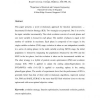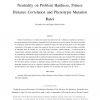294 search results - page 8 / 59 » Evolution of Fitness Functions to Improve Heuristic Performa... |
GECCO
2004
Springer
14 years 1 months ago
2004
Springer
Abstract. In many real-world applications of evolutionary computation, it is essential to reduce the number of fitness evaluations. To this end, computationally efficient models c...
IJHIS
2006
13 years 8 months ago
2006
This paper presents a novel evolutionary approach for function optimization Incremental Evolution Strategy (IES). Two strategies are proposed. One is to evolve the input variables...
ESANN
2008
13 years 10 months ago
2008
Standard learning procedures are better fitted to estimation than to classification problems, and focusing the training on appropriate samples provides performance advantages in cl...
FOGA
1992
13 years 9 months ago
1992
The building-block hypothesis states that the GA works well when short, low-order, highly-fit schemas recombine to form even more highly fit higher-order schemas. The ability to p...
TEC
2012
11 years 11 months ago
2012
Kimura’s neutral theory of evolution has inspired researchers from the evolutionary computation community to incorporate neutrality into Evolutionary Algorithms (EAs) in the hop...


